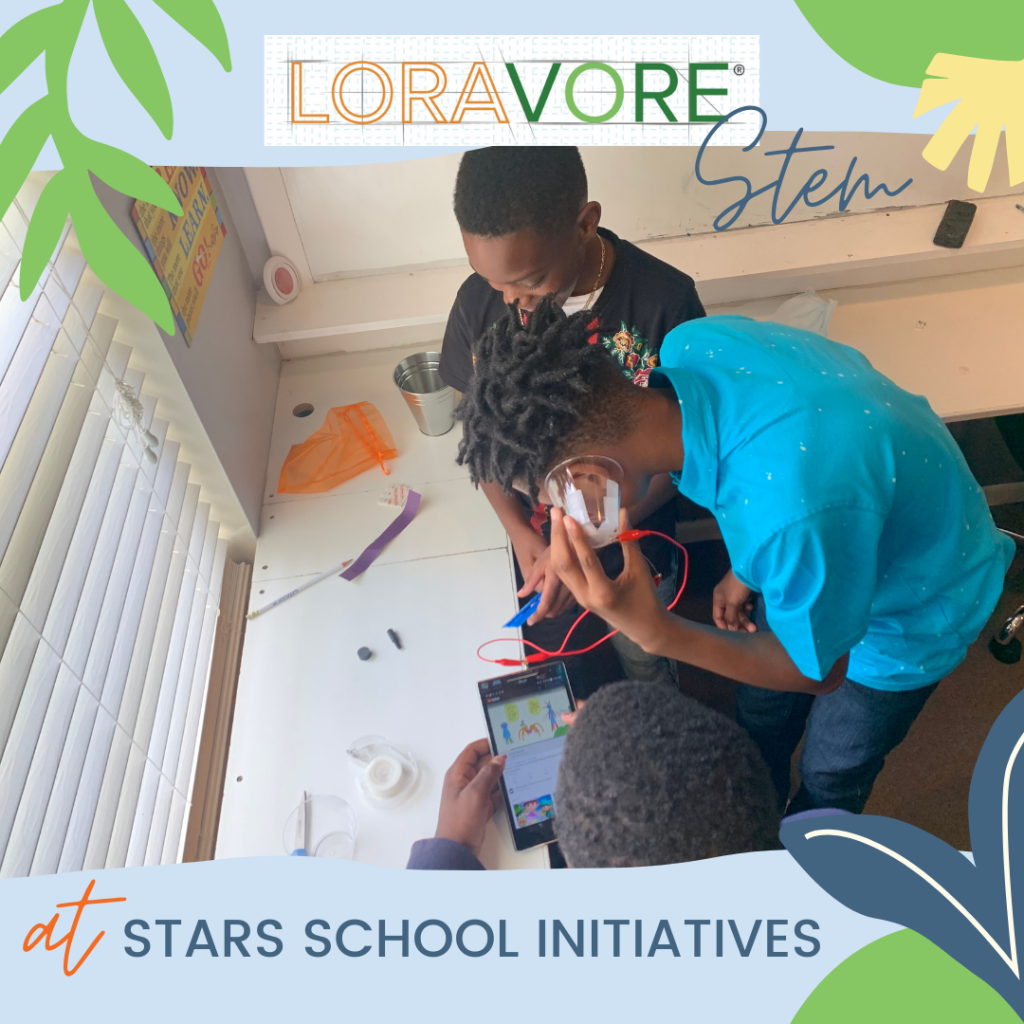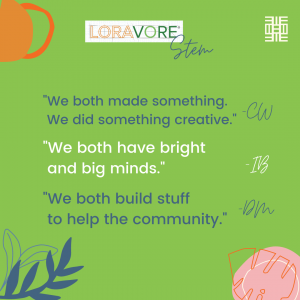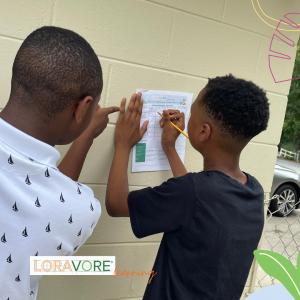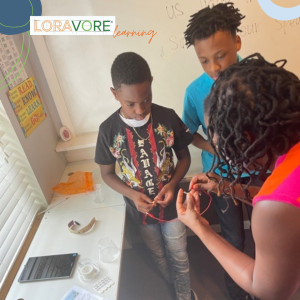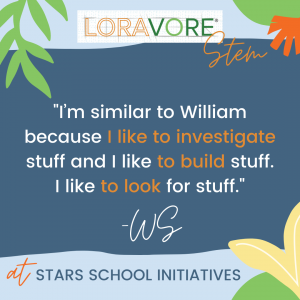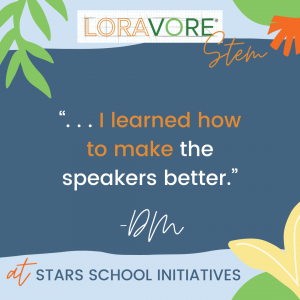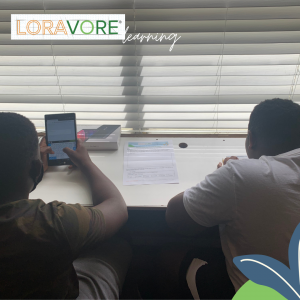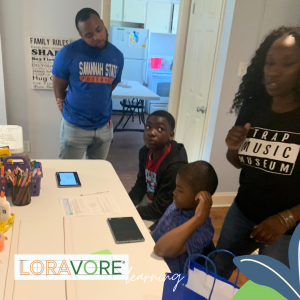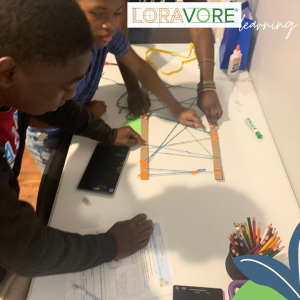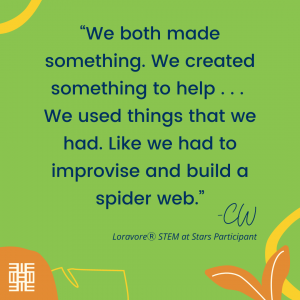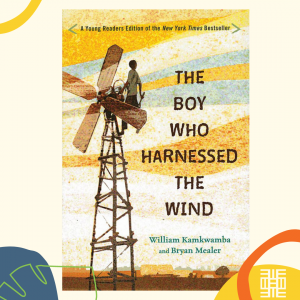
✨ These young stars at Stars School Initiatives in Savannah, Georgia, shine brightly! This summer, we’re collaborating to pilot a learning model that connects literacy and STEM learning activities through culturally-relevant texts. Follow the stars to learn more!✨
LoravoreⓇ STEM Session at Stars
Session 4: Design a Water Filter
Ms. Candace, our LoravoreⓇ STEM Learning facilitator, brings closure to this summer of learning with hope. LitWorld defines hope as “thinking optimistically and believing that today’s efforts will produce good things in the future for yourself and the world.” And what better way to inspire our young stars than with stories of engineers who hoped for and realized positive change in their communities.
During our LoravoreⓇ STEM at Stars session, our young stars “got their hands dirty” investigating different water-filtering media (charcoal, zeolite, and sand). In small groups, they collaborated to assemble a water filter in a plastic bottle and make decisions about which and how much of each medium was required. Then, they tested by filtering “yucky water” and comparing their filtered water to a scale to determine odor and clarity.
Reflections from our Young Stars!
Session 3: Design a Solar Cooker
🎶 The sun will come out tomorrow! 🎶 Not even a cloudy day can deter our LoravoreⓇ STEM Learning facilitator, Ms. Candace, and our young stars from engineering in nature. Their literacy and STEM learning was grounded in the LitWorld Strength, courage. Recognizing William of Malawi as a courageous superhero who harnessed the power of air/wind to engineer change in his community, these young stars created superheroes with nature-driven origin stories.

During our LoravoreⓇ STEM at Stars session, our young stars grew their knowledge about solar energy, reflection and absorption, maximizing the angle of the sun, and how to construct the best S’mores (😉 ). They collaborated to construct a solar oven prototype using a pizza box, craft sticks, saran wrap, aluminum foil, and construction paper. Developing their STEM practices, they observed and logged the temperature of their ovens and changes in S’more until it was time to, well eat!
Reflections from our Young Stars!
Session 2: Design for Sound
She did it again! Ms. Candace, our beloved LoravoreⓇ STEM Learning facilitator, piqued our young stars’ curiosity with connections to music (“Don’t forget about Dre”), product design (Beats Headphones), and a bit of business strategy (manufacturing cost vs purchase price).
The day before our LoravoreⓇ STEM at Stars session, she facilitated the LitClub session, which centered on curiosity, one of LitWorld’s 7 strengths. Our young stars read aloud from our central text, The Boy Who Harnessed the Wind, paying attention to William’s curiosity as he took apart old radios and conducted electrical experiments with his friend Geoffrey. Later in the session, these young stars took apart an old speaker and attempted to put it back together again.
The next day during our LoravoreⓇ STEM at Stars session, our young stars grew their knowledge about speaker components and circuits. They collaborated to build and test a speaker prototype using wire, magnets, and a plastic cup. And yes, one group even heard a sound with their speaker!
Reflections from our Young Stars!
Session 1: Design Like a Spider
Our dynamic LoravoreⓇ STEM Learning facilitator, Candace McNeal, engaged our young stars in a literary discussion about our central text The Boy Who Harnessed the Wind and the African folklore, Anansi and the Witch Named Five! Grounding them in this summer’s theme, she facilitated a discussion around problems in our local and global communities that could be solved with web-based (like the spider) designs.
After some knowledge building about spiders and webs, these young stars collaborated to design and build a prototype of a spider web with cardboard and yarn. Taking their cue from nature, our young stars considered the shape, size, and tension of their webs. Once built, they tested and evaluated how effective and efficient their webs were at catching “flies” (ping pong balls).
Reflections from our Young Stars!
Our LoravoreⓇ STEM at Stars Learning Experience
Through our bi-weekly LoravoreⓇ STEM Learning sessions, we grow learners’ awareness about how STEM connects to their personal and community lives by situating STEM learning activities in local, global, and cultural contexts.
Culturally-Relevant
Text
We engage with a central text that is culturally-relevant to ground and connect the literacy and STEM learning activities. During weekly LitClub, participants explore the text with literacy activities structured around LitWorld’s 7 Strengths. The engineering design challenges have been selected to align with themes or events in the text.
Effective Digital
Instruction
LoravoreⓇ STEM Learning is blended learning. Our facilitator leverages Pear Deck to support and assess participants’ engineering design thinking as they complete the engineering design challenge. Participants use Flipgrid to reflect on their STEM learning experiences and the impact of STEM in their worlds.
Hands-on Engineering
Challenges
During the LoravoreⓇ STEM Learning session, participants use physical materials to build prototypes that meet the engineering design challenge.
After each session, participants are provided a LoravoreⓇ STEM Learning Take-Home Kit to engineer at home with their families!
Our Partners
Additional LoravoreⓇ STEM Learning
- We Discuss Early STEM Learning!
- We Celebrate Black Herstory!
- Loravore® Learning | We Celebrate Reading!
- Facilitating Blended STEM Learning in Service of our US Military Families (Part 2 of 2)
- Facilitating Blended STEM Learning in Service of our US Military Families (Part 1 of 2)
- Our #IAmMaryJackson Herstories continue with Mrs. Phyllis Grady


